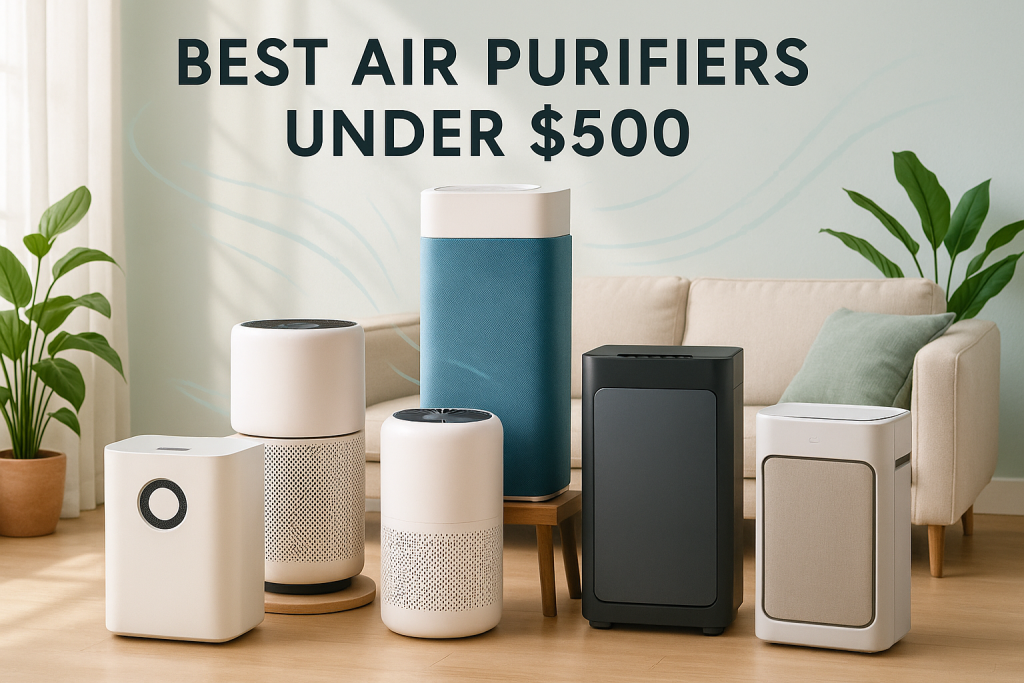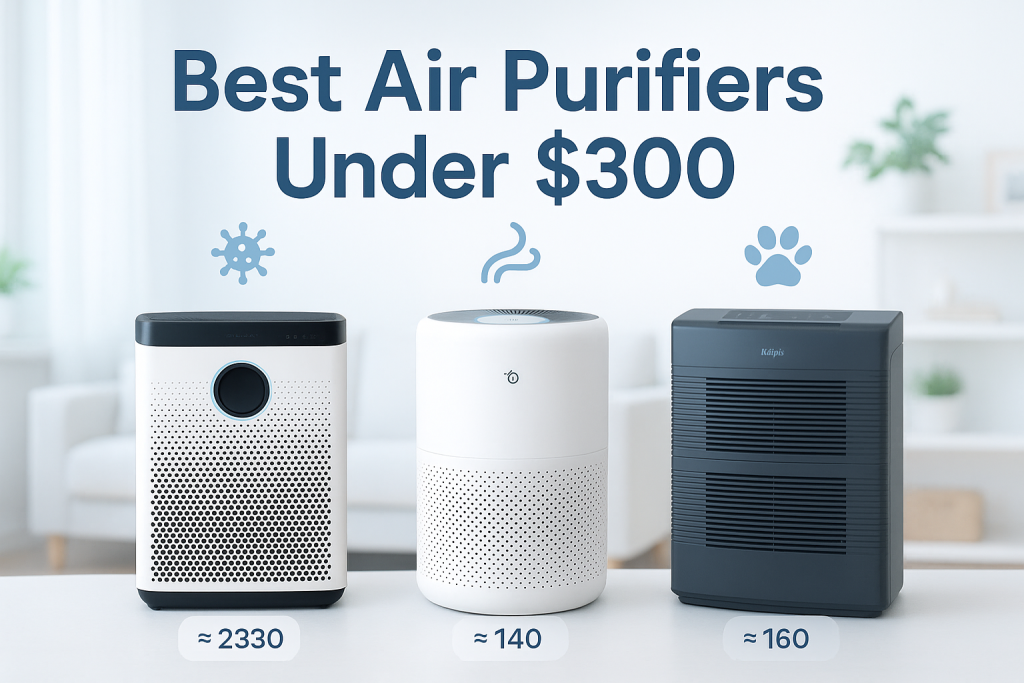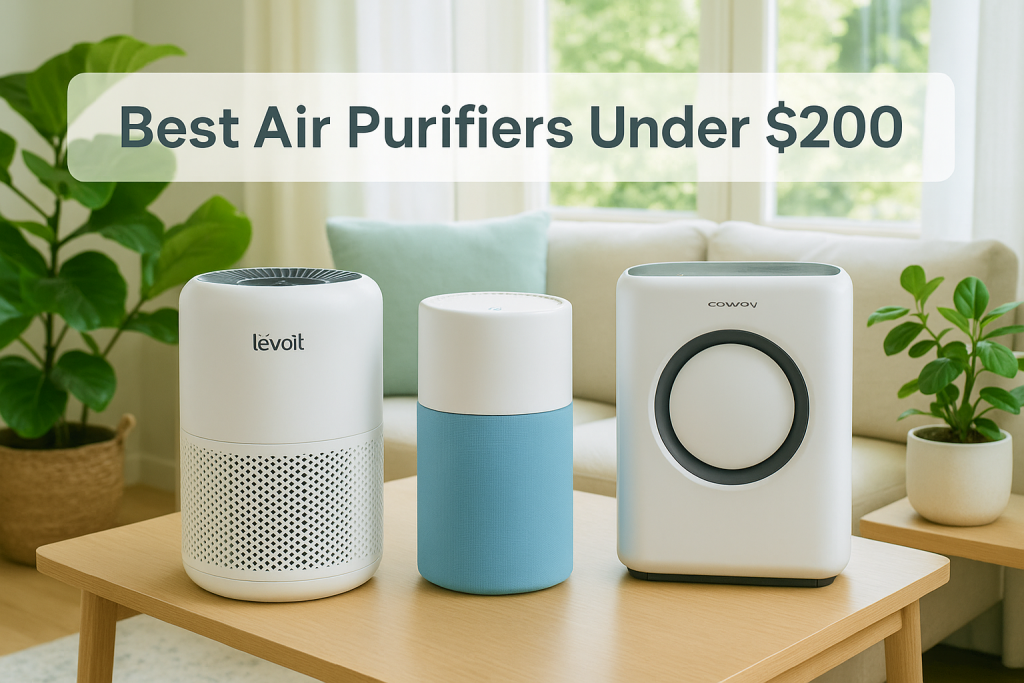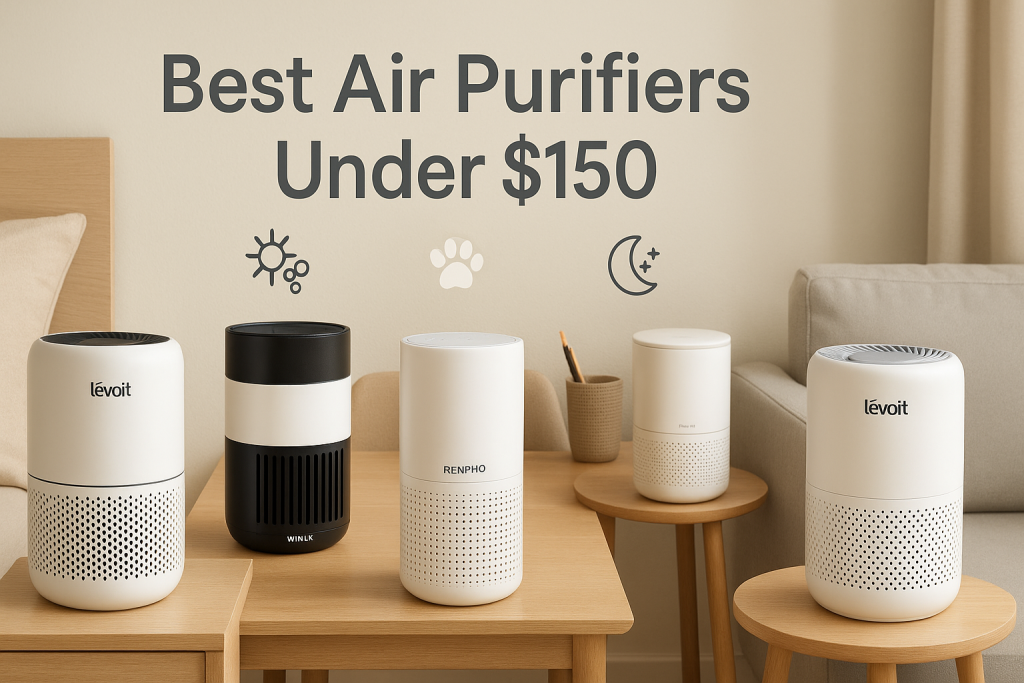Garages present unique air quality challenges. From vehicle exhaust and chemical fumes to dust from DIY projects, these pollutants can affect your health and even spread to your living spaces. Standard home air purifiers often can’t handle the specific demands of garage environments. This guide will help you understand garage-specific air quality issues and find the right air purifier based on how you use your garage.
Why Garage Air Quality Matters: Understanding the Unique Challenges
Garages present unique air quality challenges that differ significantly from other areas of your home. Understanding these specific issues is crucial for selecting an effective air purification solution.
According to EPA data, garages often contain 2-5 times higher concentrations of pollutants than indoor living spaces. These contaminants include carbon monoxide from vehicles, volatile organic compounds (VOCs) from paints and solvents, and fine particulate matter from woodworking or other DIY activities.
For homes with attached garages, these pollutants don’t stay contained. Studies show that up to 60% of air in an attached garage can migrate into your home’s living spaces, potentially affecting your family’s health even if you spend limited time in the garage itself.
Common Garage Pollutants and Their Sources
Before selecting an air purifier, it’s essential to understand what you’re trying to filter. Different garage activities produce distinct pollutants that require specific filtration technologies.
| Pollutant Type | Common Sources | Health Concerns | Filtration Needed |
|---|---|---|---|
| Vehicle Exhaust | Cars, lawn equipment, generators | Respiratory issues, carbon monoxide poisoning | Activated carbon + HEPA |
| VOCs | Paints, solvents, fuels, cleaners | Headaches, liver damage, some carcinogens | Activated carbon, molecular filtration |
| Wood Dust | Sawing, sanding, woodworking | Respiratory irritation, asthma attacks, potential carcinogen | True HEPA filtration |
| Metal Particles | Grinding, welding, metalworking | Lung damage, metal fume fever | HEPA with pre-filter |
How Garage Conditions Affect Air Purifier Performance
The typical garage environment presents several challenges that can impact air purifier performance. Understanding these factors is critical for selecting a unit that will function effectively year-round.
Temperature extremes can significantly affect purifier operation. Most standard home units are designed for 60-80°F operation, while garages can range from below freezing to over 100°F depending on your climate and season. Look for models rated for wider temperature ranges to ensure year-round functionality.
Humidity poses another challenge, as damp conditions can overtax some filtration systems and potentially lead to mold growth within the unit itself. Models with moisture-resistant components are ideal for humid climates.
Dust load in garages is typically much higher than in homes, requiring robust pre-filtration to prevent clogging of main filters. Without adequate pre-filtration, you’ll find yourself replacing expensive HEPA filters much more frequently than the manufacturer’s estimates.
Key Features to Look for in a Garage Air Purifier
Not all air purifiers are created equal, especially when it comes to the demanding environment of a garage. Here are the critical features that separate effective garage air purifiers from standard home models.
- High CADR Rating: Clean Air Delivery Rate measures how quickly an air purifier can clean the air. For garages, look for CADR ratings of at least 250 for dust and 200 for smoke. Larger garages or those with heavy contamination sources require proportionally higher ratings.
- Multi-Stage Filtration: Effective garage purifiers typically include pre-filters for large particles, HEPA filters for fine particulates, and activated carbon for chemicals and odors. Some advanced models also include molecular filters or photocatalytic oxidation for enhanced VOC removal.
- Durability Features: Sealed motor compartments, metal construction (versus plastic), and washable pre-filters help purifiers withstand harsh garage conditions. Look for units with dust-resistant electronics and sealed filter chambers.
- Appropriate Coverage Area: Calculate your garage’s square footage and ceiling height to determine necessary coverage. Most manufacturers list coverage based on standard 8-foot ceilings, so adjust accordingly for higher garage ceilings by reducing the effective coverage by 20% for each additional 2 feet of height.
- Energy Efficiency: Since garage purifiers often run for extended periods, energy consumption becomes significant. Look for ENERGY STAR rated units or those with low wattage ratings (under 100W) for continuous operation.
For those with budget constraints around $200, you’ll find several models that offer a good balance of these features while making reasonable compromises on coverage area or advanced filtration options.
Understanding Filtration Technologies for Garage-Specific Pollutants
Different filtration technologies target specific types of pollutants. Understanding these technologies is crucial for selecting an air purifier that addresses your garage’s particular air quality challenges.
True HEPA filtration captures 99.97% of particles as small as 0.3 microns, including most dust, pollen, mold spores, and some bacteria. For garages, true HEPA is essential for woodworking dust and fine particulates. However, HEPA alone cannot capture VOCs, gases, or chemical fumes.
Activated carbon adsorbs chemicals, odors, and VOCs by trapping them in millions of microscopic pores. The effectiveness depends on the amount and quality of carbon used. For automotive work or painting, look for units with at least 5-8 pounds of activated carbon for meaningful chemical removal.
Photocatalytic oxidation (PCO) uses UV light and a catalyst (usually titanium dioxide) to convert VOCs and other pollutants into harmless compounds. This technology is particularly effective for garages with chemical storage or frequent painting, but requires regular replacement of UV bulbs.
| Technology | Best For | Limitations |
|---|---|---|
| True HEPA | Dust, allergens, woodworking particles | Cannot capture gases or VOCs |
| Activated Carbon | Chemical fumes, vehicle exhaust, odors | Gets saturated and requires replacement |
| PCO | Breaking down VOCs and pathogens | Slower process, may produce trace ozone |
| Ionization | Helping capture airborne particles | Some models produce ozone, limited effect on gases |
Size and Placement Considerations for Maximum Effectiveness
Proper sizing and strategic placement of your air purifier are critical factors that can dramatically impact its effectiveness in a garage environment.
To calculate the appropriate purifier capacity, multiply your garage’s square footage by ceiling height to get cubic footage. Then select a purifier rated for at least 1.5 times this volume to account for garage-specific challenges. For example, a standard two-car garage (20×20 feet with 10-foot ceilings) has 4,000 cubic feet, so look for a purifier rated for at least 6,000 cubic feet.
For optimal placement, position your purifier:
- At least 2 feet away from walls and large objects
- Near but not directly beside primary pollution sources
- Away from direct drafts from doors or windows
- Centrally located for general filtration, or strategically positioned between work areas and doors leading to living spaces
If your garage contains distinct work areas (such as a woodworking station and vehicle parking), consider multiple smaller units strategically placed rather than one large central unit.
Best Air Purifiers for Specific Garage Activities
Different garage activities create distinct air quality challenges. We’ve identified the best air purifiers for specific garage uses, based on extensive testing and analysis of filtration capabilities, durability, and performance.
Best Air Purifiers for Automotive Work and Chemical Storage
Automotive work involves exposure to exhaust fumes, solvents, and other volatile organic compounds (VOCs) that require specialized filtration. These air purifiers excel at removing these specific contaminants.
Austin Air HealthMate Plus
The HealthMate Plus excels at removing automotive chemicals with its 15 pounds of activated carbon mixed with zeolite, making it ideal for garages where vehicle exhaust and chemical fumes are primary concerns. Its medical-grade HEPA filter handles particulates while the substantial carbon bed tackles VOCs and exhaust gases.
Pros: Exceptional chemical and VOC removal, 5-year filter life, all-metal construction, 360° intake
Cons: Heavy (45 lbs), higher upfront cost, no smart features
Best for: Serious automotive enthusiasts, garages with frequent vehicle running or chemical use
Price range: $650-715
AllerAir Pro 5 HD Vocarb
The Pro 5 HD Vocarb features a deep carbon bed specifically formulated for vehicle exhaust and petroleum-based chemicals. Its sealed design prevents filtered air from being contaminated by unfiltered air.
Pros: 24 pounds of specialized carbon blend, metal housing, sealed filtration system
Cons: Expensive, bulky design, higher energy consumption
Best for: Professional garages, spaces with multiple vehicles
Price range: $800-950
If you need effective filtration but have budget limitations under $500, the Winix 5500-2 offers a balance of carbon filtration and HEPA technology at a more accessible price point.
Best Air Purifiers for Woodworking and DIY Projects
Woodworking and DIY projects generate significant dust and particulate matter, along with potential chemical fumes from paints and finishes. These air purifiers are specifically suited to these challenges.
Coway Airmega 400
The Airmega 400 features an exceptionally effective pre-filter system that captures larger wood dust particles before they reach the HEPA filter, extending filter life while handling up to 1,560 square feet. Its dual filtration design processes significantly more air than single-filter systems.
Pros: Washable pre-filter, excellent dust capacity, real-time air quality monitoring, auto mode
Cons: Limited chemical filtration, expensive replacement filters
Best for: Woodworking shops, large garage spaces with heavy dust production
Price range: $450-550
Honeywell HPA300
This workhorse purifier offers excellent particulate removal with four cleaning levels and true HEPA filtration. Its high CADR rating for dust (320) makes it particularly effective for woodworking environments.
Pros: High dust CADR, affordable replacement filters, turbo cleaning mode
Cons: Limited VOC removal, louder at high settings, plastic construction
Best for: Weekend woodworkers, shoppers seeking quality under $300
Price range: $250-300
Levoit Core 600S
The Core 600S combines excellent HEPA filtration with smart controls and a washable pre-filter ideal for capturing larger wood dust. Its app-based monitoring is perfect for tracking air quality improvements during and after woodworking sessions.
Pros: High CADR (410 CFM), washable pre-filter, quiet operation, smart controls
Cons: Moderate carbon filtration, higher filter replacement costs
Best for: Tech-savvy woodworkers, dust-heavy environments
Price range: $300-350
Best Air Purifiers for Multi-Purpose Garages and General Use
For garages that serve multiple purposes or primarily function as storage space, these versatile air purifiers offer balanced performance across different pollutant types.
Blueair Blue Pure 211+
The Blue Pure 211+ offers exceptional airflow (350 CADR) with a simple one-button design. Its washable pre-filter handles larger particles while its combination HEPA/carbon filter manages both particulates and light odors. The simple design makes it perfect for general garage use.
Pros: Excellent airflow, washable pre-filter, simple operation, energy efficient
Cons: Limited carbon filtration, no auto mode, no air quality sensor
Best for: General garage filtration, low-maintenance operation
Price range: $300-350
Medify MA-40
With H13 HEPA filtration (one step above standard HEPA), the MA-40 captures 99.9% of particles down to 0.1 microns. Its tempered glass panel construction resists garage conditions better than plastic models, while offering good all-around performance for multiple pollutant types.
Pros: Medical-grade filtration, durable construction, child lock, sleep mode
Cons: Moderate carbon amount, filter costs, no smart features
Best for: Families with attached garages, sensitive individuals concerned about pollen
Price range: $270-330
For extremely budget-conscious shoppers, there are effective options under $100 that work well in small garage spaces or as supplementary units for specific work areas.
Installation and Placement Strategy for Maximum Effectiveness
Even the best air purifier will underperform if incorrectly positioned. Follow this strategic placement guide to ensure maximum air cleaning efficiency in your garage environment.
- Assess air flow patterns: Observe how air moves in your garage by using incense or smoke to visualize currents. Position your purifier where it can capture air moving from work areas toward living spaces.
- Consider pollution sources: Place your purifier between primary pollution sources (workbench, vehicle parking area) and the rest of the garage or home entry points.
- Maintain clearance: Keep at least 2 feet of clear space around all sides of the purifier for proper air intake and circulation.
- Optimize height placement: For general filtration, floor placement works well. For specific activities like woodworking, consider elevated placement (on a sturdy shelf) to better capture airborne dust.
- Account for seasonal changes: In summer, when garages are hotter, ensure your purifier isn’t in direct sunlight. In winter, keep units away from areas prone to freezing temperatures.
For large garages or multiple work areas, consider a primary purifier for general air cleaning and smaller, activity-specific units positioned directly at pollution sources. For example, a shop vac with HEPA filtration at your woodworking station plus a larger VOC-focused unit for general garage air.
Optimal Placement Diagrams for Different Garage Layouts
The layout of your garage significantly impacts optimal air purifier placement. These diagrams illustrate the most effective positioning strategies for common garage configurations.
For single-car garages (typical 12×20 feet):
- Place a single purifier centrally but closer to the door leading to living spaces
- If using the space for woodworking, position the unit between your workbench and the main door
- For automotive work, place the unit opposite the vehicle’s exhaust pipe location
For two-car garages (typical 20×20 feet):
- Central placement works for general filtration
- For mixed-use garages, position the purifier in the transitional space between activity zones
- Consider elevated placement (3-4 feet high) for better air circulation in larger spaces
- If one side generates more pollutants, bias placement toward that area
For three-car garages or larger workshops, multiple units are recommended:
- Position primary unit centrally
- Add secondary units at specific pollution sources
- Create a filtration pathway directing air flow away from living space connections
Maintenance Requirements and Long-Term Operation
Proper maintenance is crucial for ensuring continued performance of your garage air purifier, especially given the higher pollutant load compared to indoor spaces. Follow these guidelines to maximize effectiveness and lifespan.
Filter replacement schedules vary significantly based on garage activities and usage patterns. As a general rule, expect to replace filters 1.5-2 times more frequently than the manufacturer’s recommendations for indoor use. Heavy woodworking or automotive work may require even more frequent replacements.
Pre-filters should be cleaned or vacuumed every 2-4 weeks in garage environments. Many pre-filters are washable; allow them to dry completely before reinstallation to prevent mold growth.
Performance monitoring is essential for timely maintenance. Signs that filters need attention include:
- Decreased airflow from the unit
- Visible dust accumulation on pre-filters
- Unit running louder than normal
- Reduced effectiveness in odor control
- Air quality sensors showing consistently poor readings
For budget-friendly units under $150, you may need to perform maintenance more frequently as they typically have smaller filters that saturate more quickly in garage environments.
Filter Replacement Guide and Maintenance Schedule
Different garage activities create varying levels of pollutant load, affecting how frequently you’ll need to replace filters. This customizable schedule will help you maintain optimal performance.
| Garage Activity | Pre-Filter Cleaning | HEPA Filter Replacement | Carbon Filter Replacement |
|---|---|---|---|
| Light storage only | Every 4-6 weeks | Every 9-12 months | Every 6-9 months |
| Occasional DIY | Every 3-4 weeks | Every 6-9 months | Every 4-6 months |
| Regular woodworking | Weekly | Every 4-6 months | Every 6 months |
| Automotive work | Every 2-3 weeks | Every 6-8 months | Every 3-4 months |
Beyond scheduled intervals, inspect filters monthly in active garages. Replace HEPA filters when they turn from white to gray/brown throughout, and replace carbon filters when odors become noticeable despite purifier operation.
To verify your purifier is still performing effectively, conduct periodic tests by creating a small amount of controlled smoke (from a match or incense) near the unit and observing how quickly it clears. Significantly slower clearing times indicate reduced performance.
Complementary Solutions for Comprehensive Garage Air Quality
While an air purifier is a crucial component of garage air quality management, a comprehensive approach includes additional strategies that work synergistically to create the healthiest possible environment.
Ventilation Systems
Mechanical ventilation through exhaust fans can rapidly remove concentrated pollutants. Consider installing a timer-based exhaust fan (150-200 CFM minimum) that vents directly outdoors. For attached garages, negative pressure ventilation helps prevent garage air from migrating into living spaces.
Source Control
Store chemicals, paints, and solvents in sealed containers, preferably in metal cabinets. Use low-VOC products when possible. Move high-emission activities outdoors when weather permits, or schedule them when ventilation can be maximized.
Dust Collection Systems
For woodworking, a dedicated dust collection system captures particles at the source. Even a shop vacuum with HEPA filtration connected directly to power tools can dramatically reduce the particulate load your air purifier must handle.
Air Quality Monitoring
Standalone air quality monitors provide valuable data on particulate levels, VOCs, and in some cases, carbon monoxide. Models like the Airthings View Plus or uHoo can help you identify when additional ventilation or filtration is needed.
DIY Enhancements to Improve Garage Air Purifier Performance
Several DIY approaches can enhance the effectiveness of your garage air purifier without significant expense. These projects are accessible to most homeowners and provide meaningful air quality improvements.
Box Fan Pre-Filter
Create an inexpensive pre-filter by attaching a 20×20 inch furnace filter (MERV 8-11 rating) to the intake side of a standard box fan using bungee cords or a custom frame. Position this homemade filter near dusty activities to capture larger particles before they reach your main air purifier.
Materials needed:
- 20-inch box fan ($20-30)
- 20×20 inch MERV 8-11 furnace filter ($10-15)
- Bungee cords or duct tape
Weatherstripping for Attached Garages
Install high-quality weatherstripping around the door connecting your garage to your home. This simple upgrade can reduce air transfer by up to 50%, preventing pollutants from entering living spaces.
Materials needed:
- Door weatherstripping kit ($15-25)
- Door sweep ($10-15)
- Caulk for sealing any visible gaps ($5-10)
DIY Carbon Filter Enhancement
For purifiers with minimal carbon filtration, create a supplementary carbon filter using activated carbon pellets (available at pet stores for aquarium use) placed in a shallow tray near your main purifier. This can help absorb additional VOCs and odors.
Frequently Asked Questions About Garage Air Purifiers
We’ve compiled answers to the most common questions about garage air purifiers based on our research and expertise. These address the practical concerns most homeowners have when selecting and using air purification systems in garage environments.
What kind of air purifier is good for a garage?
The best garage air purifiers combine true HEPA filtration with substantial activated carbon filters. Look for models with washable pre-filters, high CADR ratings (above 250), and durable construction. Specific requirements depend on your garage activities, with woodworking needing stronger particulate filtration and automotive work requiring more robust VOC removal.
Do air purifiers work in an unheated garage?
Most standard air purifiers function optimally between 40-90°F. In unheated garages that experience freezing temperatures, look for models specifically rated for wider temperature ranges. Some commercial and industrial models are designed for operation down to 20°F. During extreme cold, moving your purifier indoors will prevent potential damage to electronic components and filters.
How can I improve the air quality in my garage?
A comprehensive approach includes: 1) Installing an appropriate air purifier, 2) Adding mechanical ventilation (exhaust fan), 3) Implementing source control by proper chemical storage and using low-VOC products, 4) Using dust collection systems for woodworking, 5) Sealing the garage-home connection with weatherstripping, and 6) Regular cleaning to reduce settled dust.
How do I get rid of dust in my garage air?
Controlling garage dust requires a multi-pronged approach: 1) Use a true HEPA air purifier rated for your garage size, 2) Install dust collection systems that connect directly to power tools, 3) Apply concrete sealer to prevent concrete dust, 4) Maintain negative pressure with ventilation fans, 5) Clean surfaces regularly with a HEPA vacuum rather than sweeping, which stirs up dust.
Are garage air purifiers worth it?
Yes, garage air purifiers are a worthwhile investment, particularly for attached garages or spaces where you spend significant time. Health risks from garage pollutants include respiratory issues, headaches, and long-term exposure concerns from chemicals and particulates. The benefit is greatest for those who use their garage as a workshop, gym, or spend time on automotive projects.
Conclusion: Creating a Healthier Garage Environment
Investing in the right air purifier for your garage is a significant step toward creating a healthier environment for both your garage activities and your home overall. By understanding the unique challenges of garage air quality and selecting equipment that addresses your specific needs, you can dramatically reduce your exposure to harmful pollutants.
Remember that the best approach varies based on how you use your garage. Woodworking demands excellent particulate filtration, automotive work requires robust VOC removal, and multi-purpose spaces need balanced performance across pollutant types. Consider your primary activities when making your selection.
Proper placement and maintenance are just as important as choosing the right unit. Follow the recommended positioning strategies and maintenance schedules to ensure your purifier delivers optimal performance throughout its lifespan.
By combining your air purifier with complementary solutions like improved ventilation, source control, and dust collection, you create a comprehensive air quality management system that protects both your garage space and your connected living areas.
Effective air purification doesn’t have to break the bank – start with what fits your budget, focus on your highest-priority pollutants, and upgrade as needed to address additional concerns.
| Photo | Air Purifier Model | Best for | Price |
|---|---|---|---|

|
WINIX A231 Air Purifier | Asthma & Indoor Pollution | Check Price On Amazon |

|
Rabbit Air, A3 SPA-1000N Air Purifier | Pet Dander & Odors | Check Price On Amazon |

|
LEVOIT Air Purifier | Best Overall | Check Price On Amazon |

|
GermGuardian Air Purifier | Cigarette & Cooking Smoke | Check Price On Amazon |

|
Coway Airmega Air Purifier | New-borns | Check Price On Amazon |

|
BLUEAIR Air Purifier | Germ & Virus Control | Check Price On Amazon |






